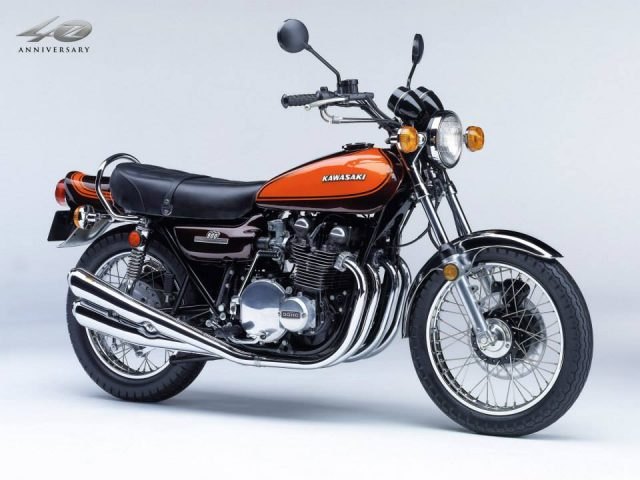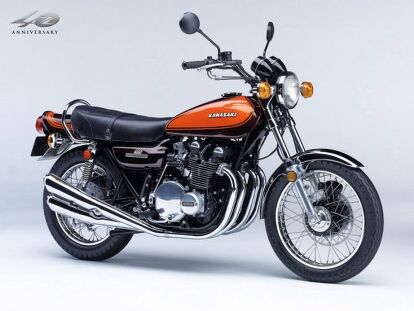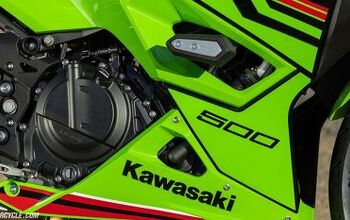1972 Kawasaki Z1 900 Vs 2018 Z900 RS Spec Chart Shootout!
I was already tuned into motorcycles in 1972, but not MOTORCYCLES. The kid down the street had a Mini Trail 50, the couple with no kids had just bought themselves his and hers Honda Elsinores for Christmas – a 125 and a 250. They let us into their rumpus room to gaze slack-jawedly upon them in all their new-bike glory. I remember the nubs on the knobbies, and the fact that they looked huge to me. When you see an old Elsinore now, it’s tiny.
I was only thinking dirt bikes in those days; 16 and a driver’s license was eons away. And then Big Kev rolled past on his new Kawasaki Z1. Actually this must’ve been 1974, which I believe was the year of the striped gas tank and still my preferred Z1 livery. The basketball came to a halt; 10 pairs of adenoids hit the driveway as one. It was the first big streetbike I remember ever noticing. It was really too big, beautiful and powerful a thing to even aspire to, like Ginger on “Gilligan’s Island.” Holey moley. Lookit those pipes man.
I don’t think I’ve ever had the pleasure of riding one of the old beasts, but I’ve ridden bikes of the era. Basically everything happens slower, requires more effort, and gives less feedback – like aquarobics pretty much.
1972 was 46 years ago, though, and since we’ve only been building motorcycles since around 1900, I suppose you should expect quite a bit of progress: The Z1 got here about 61% of the way along our development curve. Given that, it’s slightly amazing how similar the new Z900 RS homage I’m off to ride next week is to the original. Let’s have a look at the specs, why not?
| 1972 Z1 | 2018 Z900 RS | |
| Price | $1,895 ($11,372.90 in 2017 dollars) | $10,999 – 11,199 |
| Engine | 903cc DOHC inline air-cooled Four cylinder; 2 valves/cylinder | 948cc DOHC inline liquid-cooled Four cylinder; 4 valves/cylinder |
| Bore x Stroke | 66 x 66mm | 73.4 x 56mm |
| Compression ratio | 8.5:1 | 10.8:1 |
| Induction | Four 28mm Mikuni carburetors | Digital fuel injection; four 36mm Keihin throttle bodies |
| Ignition | Coil, points | TCBI w electronic advance |
| Claimed horsepower | 82 @ 8500 rpm | 110 @ 8500 |
| Claimed torque | 54.2 lb/ft @ 7000 rpm | 72.6 lb/ft @ 6,500 |
| Transmission | Wet multiplate clutch; 5-speed | Wet multiplate clutch; 6-speed |
| Chassis | ||
| Frame | Steel double-downtube cradle | Steel trellis |
| Front suspension | 36mm telescopic fork | 41mm inverted fork; adjustable rebound damping, compression damping and spring preload |
| Rear suspension | Dual shocks; adjustable for spring preload | Horizontal back-link swingarm; adjustable rebound damping and spring preload |
| Front brake | One 296mm disc, 2-piston caliper | Two 300mm discs; 4-piston calipers, ABS |
| Rear brake | Drum | 250mm disc; 1-piston caliper, ABS |
| Rake and trail | 27 degrees / 3.75 inches | 25.4 deg / 3.5 in |
| Wheelbase | 59.0 in | 58.1 in |
| Tires | 3.25-19 front; 4.00-18 rear | 120/70 ZR17; 180/55 ZR17 |
| Dimensions/capacities | ||
| Curb weight | 546 pounds | 472 lb |
| Seat height | 32.0 in | 31.5 in |
| Fuel capacity | 4.7 gallons | 4.5 gal |
The Bureau of Labor Statistics’ online calculator says $1,895 in 1972 equates to $11,372.90 in October 2017, so prices are actually coming down! (And never mind that my personal limit of about $5k for just about any motor vehicle hasn’t changed in 15 years.)
Your classic big double-overhead cam Japanese Four is still in place – DOHC was a first for a big Japanese bike – though now it’s liquid-cooled, fuel-injected, higher-compressing and 10mm shorter of stroke. Those changes result in 34% more power at, surprisingly, the same 8500 rpm, even though the new bike’s 36mm throttle bodies have way more intake area than the original bike’s 28mm carburetors; 34% more torque arrives 500 rpm sooner on the new bike. One extra pair of gears in the transmission allows you to shift gears more.
We’re still using round steel tubing for the frame, but in the new bike’s case that frame’s been designed using computers instead of men with slide rules, and welded together by robots instead of yet other humans.
You’d definitely be able to tell the difference between the old engine and the new one from the saddle, but those differences wouldn’t be as fundamental as the ones you’d feel between old and new chassis. In addition to its stiffer frame, the new bike’s inverted fork, “horizontal back link” rear suspension, and modern radial tires all work together to make those under age 40 feel like something fundamental is wrong when they climb on a bike like an old Z1. Did somebody forget to tighten something? Did somebody forget to tighten several things? People get used to imperfections when they love old things, though. Take my wife, please.
As for the brakes, there’s no comparison between the old Z1’s single disc and flimsy caliper to the new bike’s dual discs and monoblock calipers; both power and feel are way better, also the front tire. Nobody knew from stoppies in 1972, not on big street bikes anyway. And nothing but maybe the Space Shuttle had ABS in 1972 – and it hadn’t even been invented yet.
All those things are going to increase the bike’s overall stability, while letting it exploit its steeper rake angle, shorter trail (only 0.25-inch shorter, or 6mm) and inch-shorter wheelbase to turn and burn much quicker than the old one. Its biggest performance advantage, though, will be its 13.5% weight reduction, the product of a 46-year diet program. Compared to the increases in accel and decel, that’s less than you might expect. Lightness is the most expensive thing: We’re still using steel, aluminum and rubber just like in 1972, albeit less of it.
I dug the new Z900, so I’m sure I’ll like the Z900 RS fine. But I’m still holding out for the 350-pound carbon-fiber and polymer-composite two-stroke Triple replica of the real H2. I hope I’ll still be able to lift at least one leg 32 inches when it gets here.
More by John Burns













































Comments
Join the conversation
I had a 75' Z1. I have had many bikes since. None made my heart pound like my first Z1.
I had fun beating them in the drags way back in 75 with my 750 Honda. Of course I was 50 lbs lighter than any of the other riders. And we learned you never let them come out of the red line when racing. THATS how ya got power from them. Then we would trade and I would beat them with there own bike. I don`t know how they never figured it out HP per lb people if all else was equal.